Application of Multivariate Approaches to the Hydro-chemical Assessment of the Ghodaghodi Lake, Sudurpaschim Province, Nepal
DOI:
https://doi.org/10.3126/njst.v20i1.39390Keywords:
Hydrochemistry, statistical analysis, water qualityAbstract
Wetlands are considered the most diverse and productive ecosystems in the world, providing life-sustaining ecological services. Hydrochemical variables of the Ghodaghodi Lake situated in Far west Nepal were studied using multivariate statistical approaches to investigate the characteristics of water quality of the lake. A total of 10water samples were collected and analyzed for water temperature, pH, electrical conductivity, total dissolved solids, total hardness, salinity, dissolved oxygen, major ions, and dissolved Si in the pre-monsoon season during 2017.The water quality assessment was carried out by applying sodium percentage, sodium adsorption ratio, permeability index, Kelly’s ratio, magnesium adsorption ratio, action ratio of soil structural stability, and water quality index. Multivariate statistical techniques were used to evaluate the geochemical and anthropogenic processes and to identify factors influencing the ionic concentrations. The results revealed that the water was slightly alkaline with low ionic strength and remarkable spatial variations. The hydrochemistry of the lake was mainly controlled by rock weathering as the dominant Ca2+-HCO3- facies. The principal component analysis provided three major components exhibiting the diverse sources of natural and anthropogenic chemicals, including agricultural fertilizers, leakage of sewages near the human settlements, etc. The measured hydrochemical parameters indicate that lake water lies within the safe drinking water and irrigational standards. However, special consideration should be taken to control the concentrations of NO3- due to increasing anthropic activities.
Downloads
Downloads
Published
How to Cite
Issue
Section
License
Copyright (c) 2021 Ramesh Raj Pant, Khadka Bahadur Pal, Kiran Bishwakarma, Lal B Thapa, Alina Dangol, Binod Dawadi, Pramod Poudel, Binod Bhattarai, Tarka Raj Joshi, Youb Raj Bhatt

This work is licensed under a Creative Commons Attribution-NonCommercial 4.0 International License.
Authors retain copyright and grant the journal right of first publication.




